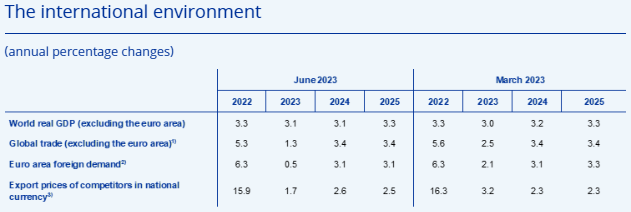The world economy started this year on a stronger footing and is expected to grow moderately over the ECB’s projection horizon, with some rebound in 2025.
In the first quarter of 2023, the global economy continued to be characterized by the major challenges of 2022, such as the ongoing Covid-19 pandemic, the war in Ukraine, rising inflation and interest rate hikes.
These challenges have had a significant impact on economic growth, trade and investment.

Global GDP growth (excluding the euro area) surprised on the upside in the first quarter of 2023, with better-than-expected growth in both China, related to an earlier and stronger-than-expected recovery following the lifting of pandemic restrictions, and in the United States, against the backdrop of a resilient labor market.
The fallout from the U.S. banking sector problems in early March led to a brief period of acute stress in global financial markets.
Since then, however, most asset classes have recovered their losses despite lingering uncertainty. The global economy (excluding the eurozone) is forecast to grow by 3.1% this year and next.
The ECB forecasts growth to rise to 3.3% by 2025.
World economy
Despite the positive momentum of economic activity, global trade remains weak, as the composition of global demand is becoming less trade-intensive, but over the medium term it should evolve more in line with real GDP growth.
The current low trade intensity of growth reflects the interaction of several factors, such as the post-pandemic shift in consumption patterns towards services and away from goods, and lower investment due to rising interest rates.
The European Central Bank (ECB) predicts global trade will expand by just 1.3% in 2023, reflecting a growth rate significantly below its long-term average and global economic growth.
As consumption patterns in advanced economies gradually normalize and investment activity picks up, global trade is expected to grow slightly faster than global GDP in 2024 and 2025. Similarly, euro area foreign demand is projected to increase, growing 0.5% in 2023 and accelerating to 3.1% in both 2024 and 2025.
The downward revision in trade forecasts for 2023 stems from weaker-than-anticipated performance at the end of 2022. However, projections for 2024 and 2025 remain stable, pointing to a gradual recovery in global and regional trade.

